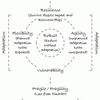Surprise surprise
Having had an online published presence for almost 20 years now it should not come as a surprise to me that every now and then I stumble across myself in the unlikeliest of places for the unlikeliest of reasons. That said, by now, based from the bits and pieces I have seen here and there, I really should no longer be so surprised that my idea of how to differ robustness from flexibility from agility from resilience resonates with quite a number of people, including Si Alhir, in his blog post on Antifragile, Flexibility, Robust, Resilience, Agility, and Fragile.
The champion of Creative Destruction
Nassim Taleb is certainly no stranger on this blog. After all, in 2009 I did review The Six Mistakes Executives Make in Risk Management, an article he co-authored in the Harvard Business Review, and that was based on his book on Black Swans from 2007. And although I read the book, I never reviewed it, but I remember that liked his ideas. His latest book “Antifragile: Things That Gain from Disorder” makes creative destruction a major point.
The father of Resilience Theory
CS Holling does not have a blog post here; in hindsight I guess he should have, because he is often recognized as one of the if not THE founding father of resilience theory, and resilience has been one of the more frequent topics on husdal.com, even more so after I turned resilience practitioner after being a resilience researcher. That said, since Holling’s main domain lies within ecology I never thought of his resilience as something that I would be particularly interested in. That is why he is only mentioned as a side note in a blog post on transportation resilience.
The Iconoclast
Gary Hamel is another almost unknown on this blog. He shouldn’t be, because bGary Hamel is one of the world’s most influential and iconoclastic business thinkers. In my small world he is mentioned in a comment on my blog post about the HBR guide to Managing External Risk, and I also mentioned him in my review of Lisa Välikangas book on The Resilient Organization, as her co-author in the article on The Quest for Resilience.
The Fantastic Four
So, in his blog post on Antifragile, Flexibility, Robust, Resilience, Agility, and Fragile Si Alhir features me and my definitions alongside those of Taleb, Hamel and Holling, and I must say that I do feel somewhat like being part of the Fantastic Four (pun intended):
However, the most interesting part of Si Alhirs blog post is not the side by side comparison, but a figure that integrates these concepts into one, and that shows how Taleb’s Fragility and Antifragility is a continuum that encloses or surrounds the other concepts.
I like this figure. In a previous blog post I explored Terje Aven’s definitions of vulnerability and resilience, and the notion that you can be generally resilient, but not generally vulnerable, only specifically vulnerable to the specific impact of a specific event relating to a specific risk. That notion now makes much more sense to me when I see fragility below vulnerability. This makes it clear that fragile is a general trait, while vulnerable is a specific trait.
A new way forward?
Taleb’s idea of antifragility is very intruiging, especially if seen the way that Si Alhir manages to put it into one figure that makes it all easy to understand and apply. That reminds me of a paper I wrote 10 years ago, in the early stages of what unfortunately did not manifest into a PhD. Anyway, in that paper – being a qualitative not a qualitative researcher – I took a liking of Giordano Bruno, the 16th century Italian philosopher. Bruno advocated the use of conceptualising, that is to think in terms of images, and he said that to think was to speculate with images. For people to understand science, according to Bruno, it ought to be rich in images and concepts, but poor in formulas.
I think that is exactly what Taleb is trying to do, and I look forward to reading his book on Antifragility, and to see how his ideas fit my own ideas. Si Alhir seems to think they do. I consider that a compliment.
Related links
- linkedin.com: Sinan Si Alhir
- salhir.wordpress.com: Antifragile, Flexibility, Robust, Resilience, Agility, and Fragile
Related posts
- husdal.com: Robustness, Flexibility, Agility and Resilience
